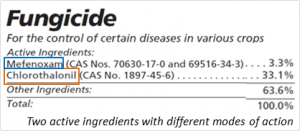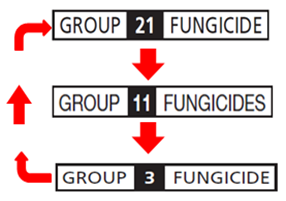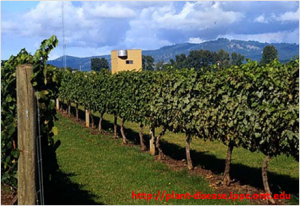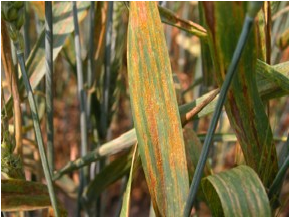A proactive approach using diverse disease control tactics is the most effective way to avoid fungicide resistance. The primary objective of this preventive strategy is to reduce selection pressure by: 1) selecting and using fungicides correctly; and, 2) managing fields, farms, or sites wisely to reduce the inoculum of the pathogen and create conditions less favorable for the disease to occur. Doing what it takes to avoid fungicide resistance is a good alternative to paying the price for overcoming resistance once it occurs.
- Select and use fungicides correctly:
- The best way to prevent resistance is to not use an at-risk fungicide. This is not a practical solution because many of the modern fungicides that are at-risk for resistance problems provide highly effective, broad-spectrum disease control. However, by reducing the number of single-site fungicide applications, you reduce the likelihood of resistance development. To minimize the impact of single-site fungicides, apply them in combinations as a tank mix or premix, ‘twin pack’ or ‘combi-pack,’ that provides multiple modes of action.
 Tank-mixes and Pre-mixes are combinations of two or more fungicides applied as a single mixture. Tank-mixing allows for adjusting of the ratio of fungicides to fit local conditions, while premixes are formulated by the manufacturer. The combination, if composed of a high-risk (single-site) fungicide with a low-risk (multisite) fungicide will contribute to resistance avoidance. The different fungicides in the mixture must be active against the target fungi so that subgroups that are resistant to one MOA are controlled by the fungicide partner with a different MOA.
Tank-mixes and Pre-mixes are combinations of two or more fungicides applied as a single mixture. Tank-mixing allows for adjusting of the ratio of fungicides to fit local conditions, while premixes are formulated by the manufacturer. The combination, if composed of a high-risk (single-site) fungicide with a low-risk (multisite) fungicide will contribute to resistance avoidance. The different fungicides in the mixture must be active against the target fungi so that subgroups that are resistant to one MOA are controlled by the fungicide partner with a different MOA.  Rotate fungicides with different mechanisms of action, not just different label names. Rotating fungicides involves alternating products so that you avoid back-to-back treatments with any one single-site fungicide or fungicides with a medium to high risk of resistance (see Spraying by the Numbers). Neither fungicide combinations nor alternating prevent the selection of resistance. The best either approach can do is slow the process. Carefully read fungicide labels to determine if any fungicides cannot be mixed or rotated together. There are often limits on the total amount to be applied, the number of allowable applications per season, and restrictions on back-to-back applications.
Rotate fungicides with different mechanisms of action, not just different label names. Rotating fungicides involves alternating products so that you avoid back-to-back treatments with any one single-site fungicide or fungicides with a medium to high risk of resistance (see Spraying by the Numbers). Neither fungicide combinations nor alternating prevent the selection of resistance. The best either approach can do is slow the process. Carefully read fungicide labels to determine if any fungicides cannot be mixed or rotated together. There are often limits on the total amount to be applied, the number of allowable applications per season, and restrictions on back-to-back applications.-
Make use of disease predictive models and scout fields frequently to effectively time applications of fungicides. The most critical time to use at-risk fungicides is early in an epidemic when the pathogen population is small. Similarly, a preventive spray program is less risky than a rescue program because selection pressure is applied to fewer individuals. Use multisite fungicides in later parts of the growing season when disease pressure is often greatest. Pathogens that have multiple generations in a growing season, have a high reproductive rate, and are aerially dispersed are more prone to develop resistance and become a problem. In contrast, soilborne pathogens produce fewer offspring per season than their foliar counterparts. Where an at-risk fungicide is used for soilborne disease control, resistance development is likely to be slow because comparatively few individuals are exposed to selection pressure.
- Apply labeled rates with adequate coverage of the foliage to produce good disease control.
- If applicable, use a seed or soil fungicide treatment that requires only one or two applications per season, thus keeping the risk of resistance low.
- Following application, monitor the field to determine how well the fungicide worked and for signs of any failure.
- The best way to prevent resistance is to not use an at-risk fungicide. This is not a practical solution because many of the modern fungicides that are at-risk for resistance problems provide highly effective, broad-spectrum disease control. However, by reducing the number of single-site fungicide applications, you reduce the likelihood of resistance development. To minimize the impact of single-site fungicides, apply them in combinations as a tank mix or premix, ‘twin pack’ or ‘combi-pack,’ that provides multiple modes of action.
- Manage fields, farms, or sites wisely:
- Select resistant varieties of plants/crops that are less susceptible to important pathogens. Pathogens reproduce at higher rates on susceptible varieties compared with resistant or partially resistant varieties.
 Capitalize on cultural practices to reduce the pathogen
Capitalize on cultural practices to reduce the pathogen
population or create conditions less favorable for the pathogen to develop. When fewer non-chemical control methods (such as sanitation) are used, resistance is more
likely to develop, or will develop more rapidly.- Monitor and maintain agronomic factors such as soil moisture and crop nutrition, and manage other pests, to avoid crop stress throughout the season.
- Inadequate or excessive fertilization with nitrogen may increase disease incidence in some crops. For example, early blight of potato and tomato and dollar spot of turfgrass are favored by nitrogen deficiency. Alternatively, the severity of spring dead spot of bermudagrass and some foliar diseases of wheat is increased with intensive nitrogen fertilization.
- Excessive irrigation or frequent irrigation with small amounts of water increases the incidence of many diseases by promoting spread of the pathogen and extending periods of leaf wetness, and high soil moisture.
- Rotate crops to allow greater flexibility in choosing different tillage practices and/or the use of fungicides with different MOAs. Be aware that applying a fungicide unnecessarily to a crop in one year in the absence of fungus could result in undesirable effects on pathogens of rotational crops. NOTE: It is possible to rotate different crops between years and, yet, still use the same fungicide MOA to control the same disease. When one crop can serve as a source of inoculum for a subsequent crop, the alternation scheme among at-risk fungicides should be continued between successive crops such that the first at-risk fungicide applied to a crop belongs to a different group than the last at-risk fungicide applied to the previous crop.
- Be aware that resistant plant pathogens can spread from nearby fields, highways, railroads, or utility rights-of-way areas near your farm or treated site. Local and regional cooperation in resistance management is essential. Participate in Extension programs that conduct area-wide monitoring for the presence of disease pathogens and potential resistance development. Submit reports of fungicide control failures so that the possibility of resistance can be monitored and evaluated.
The “FRAC List of Plant Pathogenic Organisms Resistant to Disease Control Agents” is updated regularly at www.frac.info (download the “List of Resistant Plant Pathogens” from the Publications Section). The list identifies plant pathogens that have shown some form of resistance in commercially treated fields. Inclusion of the pathogen in this list only demonstrates that it can become resistant. It does not indicate that pathogen populations in specific geographic areas or locations are resistant. Consult with an Extension plant pathologist or other expert to estimate the resistance risk for specific fungi, fungicide, and crop combinations in your location.
Compiled by Dr. Wayne Buhler, PhD

